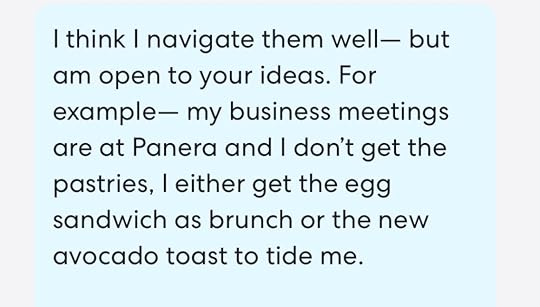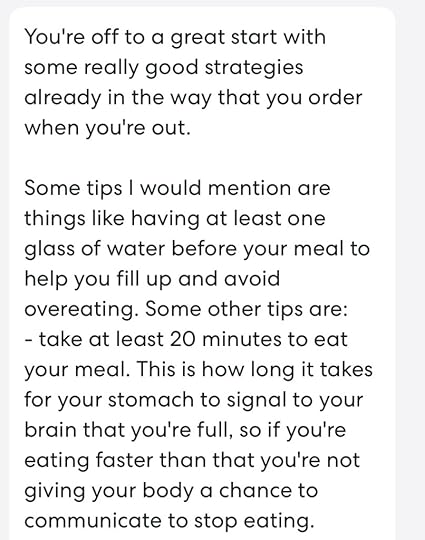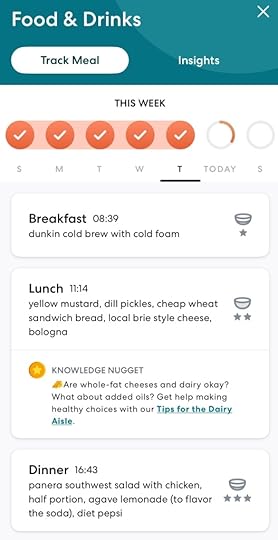Day 5 of Omada: Wondering if it’s a scam
I feel like I have said a lot of this a lot of times so bear with me as I say it again.
The backgroundAbout 10 years ago, I decided to try to lose five-to-ten pounds. Approaching my 40th birthday, I needed to shed some weight before my annual physical. I worked at Target at the time where I walked 14,000 to 17,000 steps a day. I started weight training again, primarily because I had broken my right hand at work and could not untwist the soda fountain nozzles at night. No hand strength left. I worked primarily closing shift and I would get up, do my weights and walk 2-4 miles around my neighborhood. Every day. I counted calories and perfected my macronutrients and I felt invincible.
I lost 30 pounds in less than six weeks– while weight training. I dropped too much too fast and I had to buy a fitbit to make sure I was eating enough.
I worked really hard to regain weight and muscle.
But now, I’m approaching fifty. I have reached an all-time high with my weight– weighing the same thing I did on the day my daughter was induced 20 years ago. I have gained a little more than 30 pounds in the four years since the pandemic and a lot of other personal events.
And as someone with a mobility disability, that weight impacts everything even more than it does for the average person. I went to the gym religiously for three years, but I didn’t have the willpower or the finances to stick with good habits. Because it’s cheaper to eat the $1 McChicken and $1 diet Coke than it is to make your own chicken sandwiches.
The present decision: OmadaI know what to do. I understand nutrition and everything I do wrong. But I need someone to hold me accountable because my personal discipline is gone. Today is my sixth day participating in Omada– a free-to-me program through my medical insurance company– and I went on a small binge last night.
Perhaps my opinions will change, but I think Omada is a scam. And I think the bulk of the program is driven by AI.
But let me summarize the philosophy of the program.
There is no calorie counting. No exercise tracking but steps. So if you want your weight-training to count you have to convert it to steps, which makes no sense. I understand the idea behind tracking meal choices and not calories or macros. The program wants you to study your choices and habits to make meaningful change.
I’m using the Omada app AND MyFitnessPal and I’m still not making good choices or creating positive change. I’ve participated in my group’s discussions. And I’ve sent a long introductory message to my coach. And I reported a tech issue regarding my scale the day I received it.
I remedied the problem with the scale, so I thought they saw that I was using it and that’s why they didn’t get in touch. Turns out, it just took a week.
So I told my coach my history, and after the first day of tracking she mentioned she saw evidence of stress eating in my day’s choices. I thought to myself, “Really?”
Now to me, stress eating is eating a family size bag of Cool Ranch Doritos. I reviewed my first day’s food. For lunch I had one leftover slice of pizza because I came home from a meeting extremely hungry, and in the evening I had a small individual bag of vegan gummy bears. My calorie count for the day ended around 1400.
Did she think I ate a whole pizza?
I replied, “It was just a busy day. I had a lot of meetings, but I think I made good choices.”
She asked, “Would you like some strategies for eating on the go?”
And I responded, “I have my strategies, but many of them include food I can’t afford right now like my KIND oatmeal breakfast bars that have 8 grams of protein perfect to tide me, and I don’t eat out because my grocery budget is around $100/month.”
Which if you ever read my posts on grocery shopping, you’ll know that’s true.
 Screenshot
Screenshot
 Screenshot
Screenshot
 Screenshot
ScreenshotShe responded with tips like eating slower and putting my utensils down (which my message to her pointed out that I did not eat before the meeting, came home very hungry and then took the easy way out, which has nothing to do with eating too much at meals) and how to be smarter about eating out (when I said I don’t have the money to eat out). I believe this list of suggestions came from a chat bot who recognized the phrase “meetings” “busy” and “on the go.”)
No mention of the fact that my grocery budget is below poverty level. A person might want to address that first.
The researchMy reporter’s instincts kicked in at this point.
I was already perturbed that it gave me a step goal of 7500 a day without any consideration of my health, my current activity level or my goals.
As a person who works at home at my desk for nine to twelve hours a day I get about 4000 steps on an average day. If I walk to do my errands or take a leisurely stroll around the mall, I get 6500 steps. The last time I hit 10,000 steps I spent the next day in painful muscle spasms. My point is– you need to gradually increase your activity level, especially if you have preexisting conditions.
To qualify for Omada, you need to have a weight problem, a heart condition or diabetes (or prediabetes). I am overweight, ended up in the hospital with Afib last year and had gestational diabetes which puts me at risk for prediabetes. AND I have cerebral palsy.
For people with heart conditions or obesity, is it safe to suddenly walk 7500 steps a day?
I looked online. How does Omada get paid?
Insurance companies pay Omada based on how much patients interact with their devices.
So, Omada gets paid every time I step on the scale.
This is bullshit.
And last night, after a day of decent eating, I added on an extra 500 calories of a peanut chew-style candy, gin and juice and freeze-dried fruit that I didn’t put on the app.
 Screenshot
Screenshot
 Screenshot
Screenshot



